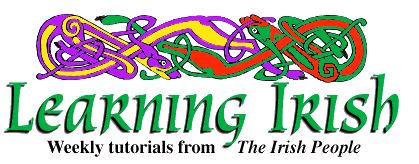
Irish Lesson 17
|
PRONUNCIATION You know the basics of pronunciation by now. Although you should be able to sound out most new words, we will continue to give you the pronunciation guide for all new words--and most of the old ones, too--for a few more lessons. We will also begin reviews to help you maintain your pronunciation if you have no speakers, records, or tapes available. We will now begin to take up some of the details of pronunciation and some of the regional variations. First, the word "maith" (mah), good. The "th" at the end of the word means that the vowel sound of (ah) gets cut short, rather than running long as it if were (maaah). We do the same in English sometimes. For example, when you say "ah" to indicate pleasant surprise, the sound is held for a much longer time than when you say "ah" to indicate disgust or impatience. In the second "ah", you cut the sound off short, as you do for the Irish word "maith". This cutting short of the sound for "th" also occurs inside words, usually at the end of a syllable before a vowel, as in: leathan (LA-huhn), wide; athair (A-hir), father. We will indicate where this happens from now on. At the start of a word, "th" gets an (h) sound, like English "h". For example: tharla sé (HAHR-luh shay*), it happened. "Maith" is pronounced (meye) in some parts of Ireland, and you must learn to listen for this. If a speaker says (goh MEYE), you will know that it is the equivalent of the (go MAH) that you have learned. Regional differences exist in Ireland, as in the United States where, for example, the word "rifle" may be pronounced (REYE-fuhl), (RAH-fuhl) or (ROY-fuhl) along the Eastern seaboard alone. GRAMMAR Irish has no word for the verb "to have". Instead, Irish speakers say the equivalent of "it is at me" or "the book is at him". The preposition "ag" (eg), at, serves here. "A man has the book" becomes "Tá an leabhar ag fear" (taw* un LOU-wuhr eg far), the book is at a man. This is very annoying at first to the average English speaker, because it requires him to rearrange his thought patterns slightly. WIth a little practice and drill, however, it will become second nature to you. The preposition "ag" combines with "me", tú", and other pronouns to form the following, which you should learn now: agam (uh-GUHM), at me agat (uh-GUHT), at you aige (eg-GE), at him aici (a-KI), at her againn (uh-GIN), at us agaibh (uh-GIV), at you (plural) acu (ah-KUH), at them The term "ag an" (eg un) means "at the" and it often causes eclipsis. For example, "at the man" becomes "ag an bhfear" (eg un VAR). We will drill on this to make you fluent in the form.
VOCABULARY cuirtín (koor-TEEN), curtain sáspan (SAW*S-puhn), saucepan lampa (LAHM-puh), lamp buicéad (bwi-KAY*D), bucket crúscín (kroosh-KEEN), jug, pitcher cófra (KOH-fruh), cupboard buidéal (bwi-DAY*L), bottle ciseán (ki-SHAW*N), basket; ciseán páipéir (paw*-PAY*-ir), wastebasket Feminine Nouns fuinneog, an fhuinneog (fwin-YOHG, un in-YOHG) window scuab, an scuab (SKOO-uhb), broom, brush Verbs faigh, ag fáil (feye, uh FAW*-il), get cuir, ag cur (kir, uh-KUHR), put glan, ag glanadh (gluhn, uh GLUHN-uh), clean tóg, ag tógáil (tohg, uh TOHG-aw*-il), take, lift stad, ag stad (stahd), stop DRILL First, for "have": Tá cupán agam (taw* ku-PAW*N uh-GUHM), I have a cup. Tá cupán agat (taw* ku-PAW*N uh-GUHT), You have a cup. Tá cupán aige (taw* ku-PAW*N eg-GE), He has a cup. Tá cupán aici (taw* ku-PAW*N a-KI), She has a cup. Tá cupán againn (taw* ku-PAW*N uh-GIN), We have a cup. Tá cupán agaibh (taw* ku-PAW*N uh- GIV), You (pl) have a cup. Tá cupán acu (taw* ku-PAW*N ah- KUH), They have a cup. Next, go through the negatives: Níl cupán agam (neel ku-PAW*N uh-GUHM), I don't have a cup. Níl cupán agat (neel ku-PAW*N uh-GUHT), You don't have a cup. And so on. Then the questions: An bhfuil cupán agam? (un vwil ku-PAW*N uh-GUHM), have I a cup? And so on. Finally, the negative questions: Nach bhfuil cupán agam? (nahk* vwil ku-PAW*N uh-GUHM, Don't I have a cup? And so on. You are now ready, after a short rest, for a progressive drill. Go through this form: Nach bhfuil leabhar ag Seán? (nahk* vwill LOU-wuhr eg shaw*n), Hasn't John a book? Níl leabhar ag Seán. An bhfuil leabhar ag Máire? (MAW*-re). Has Mary a book? Tá leabhar ag Máire. Continue with "Máire", but then substitute: Séamas, Liam, Bríd, Úna and Diarmaid in succession. Your last sentence will be: Tá leabhar ag Seán. Each time you say a sentence, form a picture of a person holding a book or without a book. For the second drill, go to the kitchen again and run through: Céard é seo? or Céard é sin? for each object in the kitchen as given in the vocabularies of Lesson 16 and this lesson. Also, ask the question "cá bhfuil an _____" (kaw* vwil un _____). Where is the _____? for each object and answer by "Tá sé _____", using the phrases in the drill of Lesson 16. Visualization of the object should be easy, since it will be before you. (c) 1997 The Irish People. May be reprinted with credit. |